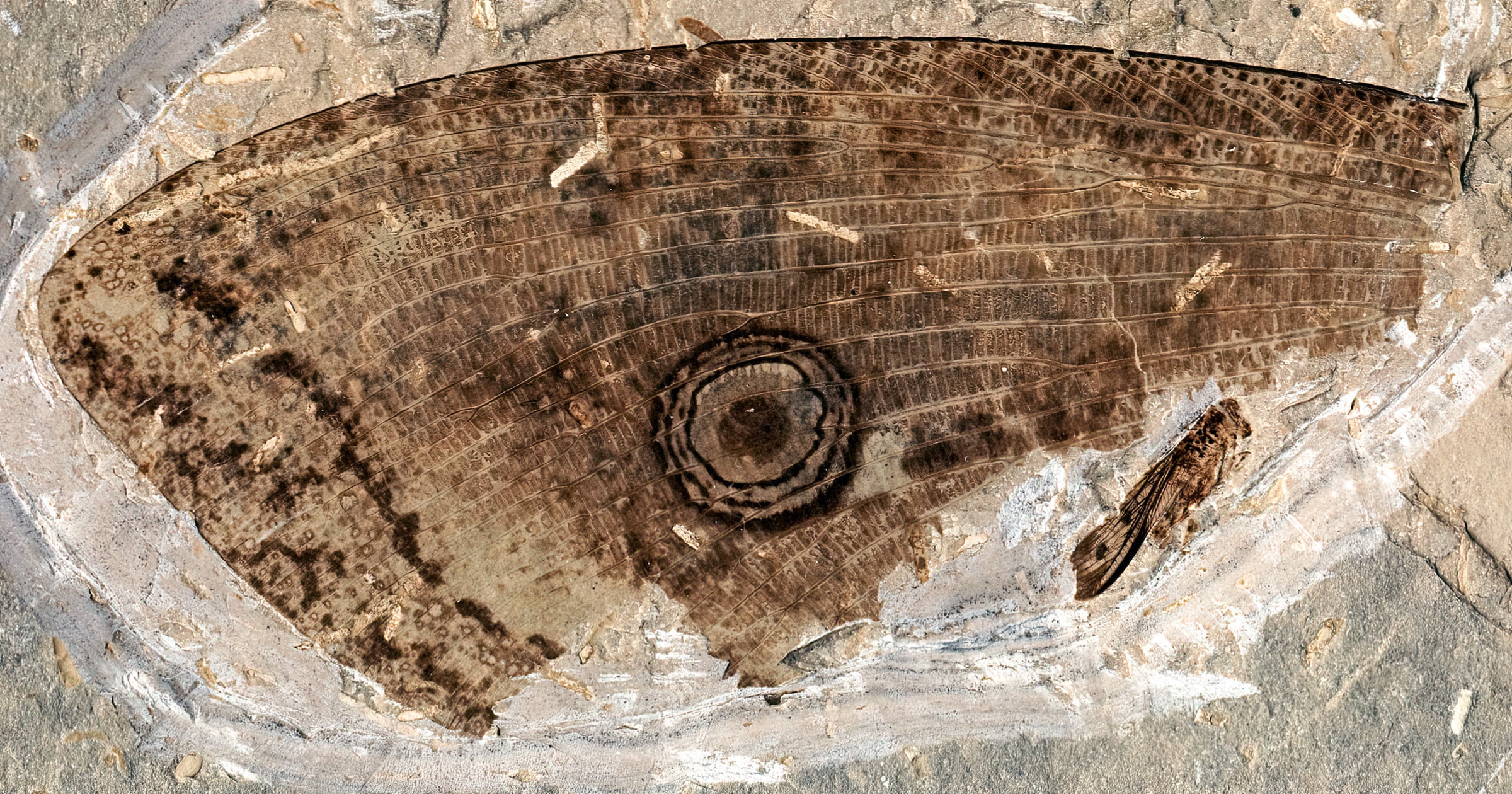 Paleontology
Paleontology
Fossil Friday: A Fossil Butterfly Lookalike

This giant and wonderfully preserved fossil insect wing belonged to a specimen of the extinct lacewing family Kalligrammatidae. The fragment is 78 mm long, but the complete wing had an estimated length of 100-120 mm and thus a wing span of about 9 inches. The preservation of color pattern is typical for the unweathered greyish layers of the Lower Cretaceous Crato Formation from northeast Brazil. Together with a Russian colleague, I described this fossil as a new species Makarkina kerneri (Bechly & Makarkin 2016). Its sister species, Makarkina adamsi, from the same locality, even reached a wing span of maximally 33 cm, which makes it to the largest known neuropteran insect that ever existed. A third species of this genus was described from the same locality by Machado et al. (2020). The genus Makarkina is the only American representative of the Kalligrammatidae, which are otherwise known in about 61 species from the Lower Jurassic to the early Late Cretaceous of Europe and Asia.
The family Kalligrammatidae is remarkable for its similarity to butterflies. Indeed they were often colloquially called “butterflies of the Jurassic.” The similarity goes deeper than just the shape of the wings and their conspicuous eyespots (Machado et al. 2020). Most species have the wings covered with scales, just like butterflies and unlike most other insects (Yang et al. 2014, Labandeira et al. 2016). But there is more: When well preserved specimens from China were discovered, that also showed details of the body morphology, it turned out that kalligrammatids had highly specialized mouth parts in the form of a long proboscis that is anatomically similar to that of butterflies (Labandeira 2010, Liu et al. 2018). Most other neuropterans have chewing mouthparts similar to beetles. The combination of several distinct and unique similarities with butterflies in the same group of insects, that is not closely related to butterflies at all, is another striking case of convergence (Labandeira et al. 2016).
Unexpected Under Darwinism
When I studied biology at the University of Tübingen in the 1980s, it was still believed that convergence is a rare phenomenon that causes little trouble for the reconstruction of phylogenetic relationships. Since that time it turned out that convergences are a ubiquitous phenomenon in all groups of organisms, so that whole symposiums have been dedicated to this problem (Agrawal 2017). Stephen Jay Gould (1989) still thought that replaying the “tape of life” would result it radically different outcomes. The modern view is very different and rather the opposite: life produced the same solutions and over and over again. Renowned paleontologist Simon Conway Morris wrote several articles and books about this issue (Conway Morris 2003, 2007, 2010, 2015, 2016). This is unexpected under Darwinism, and therefore requires ad hoc explanations like constraints, underlying apomorphies, genetic predispositions, and of course the universal magic wand natural selection (Losos 2011, Powell 2012, Stayton 2015). An intelligent design paradigm can more easily accommodate convergences as a natural consequence of a designer reusing the same ideas in different constructions. Reuse of elements is a typical design pattern.
References
- Agrawal AA 2017. Toward a Predictive Framework for Convergent Evolution: Integrating Natural History, Genetic Mechanisms, and Consequences for the Diversity of Life. The American Naturalist 190(S1), S1 – S12. DOI: https://doi.org/10.1086/692111.
- Bechly G & Makarkin VN 2016. A new gigantic lacewing species (Insecta: Neuroptera) from the Lower Cretaceous of Brazil confirms the occurrence of Kalligrammatidae in the Americas. Cretaceous Research 58, 135 – 140. DOI: https://doi.org/10.1016/j.cretres.2015.10.014.
- Conway Morris S 2003. Life’s Solution: Inevitable Humans in a Lonely Universe. Cambridge: Cambridge University Press.
- Conway Morris S 2007. Darwin’s Compass: How Evolution Discovers the Song of Creation. Gifford Lectures. https://www.giffordlectures.org/lectures/darwins-compass-how-evolution-discovers-song-creation
- Conway Morris S 2010. Evolution: like any other science it is predictable. Philosophical Transactions of the Royal Society B 365(1537), 133–145. DOI: https://doi.org/10.1098/rstb.2009.0154.
- Conway Morris S 2015. The Runes of Evolution: How the Universe Became Self-Aware. Templeton Press, West Conshohocken (PA), 528 pp.
- Conway Morris S 2016. Evolutionary convergence. Current Biology 16(19), R826–R827. DOI: https://doi.org/10.1016/j.cub.2006.08.077.
- Gould SJ 1989. Wonderful Life: The Burgess Shale and the Nature of History. W.W. Norton & Co., New York (NY), 347 pp.
- Labandeira CC 2010. The Pollination of Mid Mesozoic Seed Plants and the Early History of Long-proboscid Insects. Annals of the Missouri Botanical Garden 97, 469–513. DOI: https://doi.org/10.3417/2010037.
- Labandeira CC, Yang Q, Santiago-Blay JA et al. 2016. The evolutionary convergence of mid-Mesozoic lacewings and Cenozoic butterflies. Proceedings of the Royal Society B 283:20152893, 1–9. DOI: https://doi.org/10.1098/rspb.2015.2893.
- Liu Q, Lu X, Zhang Q, Chen J, Zheng X, Zhang W, Liu X & Wang B 2018. High niche diversity in Mesozoic pollinating lacewings. Nature Communications 9:3793, 1–11. DOI: https://doi.org/10.1038/s41467-018-06120-5.
- Losos JB 2011. Convergence, Adaptation, and Constraint. Evolution 65(7), 1827–1840. DOI: https://doi.org/10.1111/j.1558-5646.2011.01289.x.
- Machado RJP, Freitas AVL & Ribeiro GC 2020. A new giant species of the remarkable extinct family Kalligrammatidae (Insecta: Neuroptera) from the Lower Cretaceous Crato Formation of Brazil. Cretaceous Research 120:104724, 1–10. DOI: https://doi.org/10.1016/j.cretres.2020.104724.
- Powell R 2012. Convergent evolution and the limits of natural selection. European Journal for Philosophy of Science 2, 355–373. DOI: https://doi.org/10.1007/s13194-012-0047-9.
- Stayton CT 2015. What does convergent evolution mean? The interpretation of convergence and its implications in the search for limits to evolution. Interface Focus 5(6):20150039, 1–8. DOI: https://doi.org/10.1098/rsfs.2015.0039.
- Yang Q, Wang Y, Labandeira CC, Shih C & Ren D 2014. Mesozoic lacewings from China provide phylogenetic insight into evolution of the Kalligrammatidae (Neuroptera). BMC Evolutionary Biology 14:126, 1–30. DOI: https://doi.org/10.1186/1471-2148-14-126.
